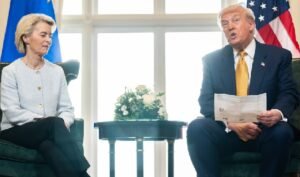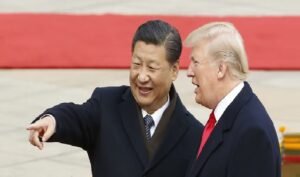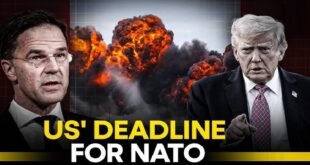02-08-2025
WASHINGTON: In April Donald Trump stunned the world by announcing sweeping new import tariffs only to put most on hold amid the resulting global financial panic.
Four months later, the US president is touting what he claims are a series of victories, having unveiled a handful of deals with trading partners and unilaterally imposed tariffs on others, all without the kind of massive disruptions to the financial markets that his spring attempt triggered. At least, so far.
 Having worked to reorder America’s place in the global economy, Trump is now promising that the US will reap the benefits of new revenue, rekindle domestic manufacturing, and generate hundreds of billions of dollars in foreign investment and purchases.
Having worked to reorder America’s place in the global economy, Trump is now promising that the US will reap the benefits of new revenue, rekindle domestic manufacturing, and generate hundreds of billions of dollars in foreign investment and purchases.
Whether that turns out to be the case and whether these actions will have negative consequences, is still very much in doubt.
What is clear so far, however, is that a tide that was (gently) turning on free trade, even ahead of Trump’s second term, has become a wave crashing across the globe. And while it is reshaping the economic landscape, it hasn’t left the kind of wreckage in its wake that some might have predicted though of course there is often a lag before impact is fully seen.
What’s more, for many countries, this has all served as a wakeup call, a need to remain alive to fresh alliances and so, while the short term result might be, as Trump sees it, a victory, the impact on his overarching goals is far less certain. As are the long-term repercussions, which could well pan out rather differently for Trump or the America he leaves behind after his current term.
The ‘90 deals in 90 days’ deadline
For all the wrong reasons, 1 August had been ringed on international policymakers’ calendars. Agree new trading terms with the US by then, they’d been warned or face potentially ruinous tariffs.
While White House trade adviser Peter Navarro predicted “90 deals in 90 days” and Trump offered an optimistic outlook on reaching agreements, the deadline always appeared to be a tall order and it was.
 By the time the end of July rolled around, Trump had only announced about a dozen trade deals, some no more than a page or two long, without the kind of detailed provisions standard in past negotiations.
By the time the end of July rolled around, Trump had only announced about a dozen trade deals, some no more than a page or two long, without the kind of detailed provisions standard in past negotiations.
The UK was first off the blocks, perhaps inevitably. Trump’s biggest bugbear is, after all, America’s trade deficit, and trade is in broad balance when it comes to the UK.
While the baseline 10% applied to most British goods may initially have raised eyebrows, it provided a hint of what was to follow and in the end came as a relief compared to the 15% rate applied to other trading partners such as the EU and Japan, with whom the US has larger deficits; $240bn and $70bn respectively last year alone and even those agreements came with strings attached. Those countries that weren’t able to commit to, say, buying more American goods, often faced higher tariffs.
South Korea, Cambodia, Pakistan, as the list grew, and tariff letters were fired off elsewhere, the bulk of American imports are now covered by either an agreement or a presidential decree concluded with a curt “thank you for your attention to this matter”.
Capacity to ‘damage’ the global economy
Much has been revealed as a result of this.
First, the good news. The wrangling of the last few months means the most painful of tariffs, and recession warnings, have been dodged.
The worst fears, in terms of tariff levels and potential economic fallout (for the US and elsewhere) have not been realized. (Int’l News Desk)
 Pressmediaofindia
Pressmediaofindia




